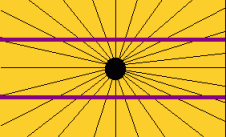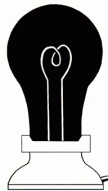Originally published March 23, 2013
This week I am going to share an epiphany. It didn’t help me completely solve the problem of the moment, but it did give me a clearer picture of what it would mean to be inside my husband’s head. It kept a situation from turning into another cycle of stress and emotional upheaval. I’m not sure how long this euphoric moment will last, but it is an insight worth sharing.
As with all insights, this one did not spring fully formed into my head; it was the result of accumulated information and experience that finally fell into some useful bit of realization. Ever since I have acknowledged my husband’s dementia (about two years now) I have been reading, searching, learning, watching and digging up every piece of relevant information I could find. This, of course, is part of the reason I wrote the book, Who I Am Yesterday. This week I took another step in understanding that incredible organ snuggled in our cranium called the brain.
The adult human brain weighs approximately 3 pounds, only 2% or less of our body weight. It consumes 25% of our intake of oxygen, 70% of the glucose we consume and 25% of any nutrients we consume. It contains some 100 billion neurons and somewhere around 100,000 miles of vessels, capillaries and other transport systems. Those vessels pump 1.5 pints of blood through the brain each minute. All those little neurons are connected through 1 quadrillion connections. Some 83% of the neurons are in the cerebral cortex which consists of 6 layers. The cerebral cortex is all bunched up on the surface of the brain so it will fit inside our craniums. Total surface area would stretch out to something like 16” X 22”. And that’s just the cognitive part.
Neuroscience has discovered much about how the brain operates, and we’ve only, well, scratched the surface. We are, however, learning how memories are formed, and how the brain can “rewrite” its own memory, change relationships between memories, burn some deeper than others, or forget everything all together. Memory, in fact, helps us build our perception of our future. We are also learning something about what makes some of us geniuses, and what causes the truly brilliant mind to dance so closely to madness; or to fall completely under its spell.
I say all of this because how the brain works utterly fascinates me. Both because, at heart, I am a philosopher and because it shows me much of what my husband has been and what he is now. It gives me a perspective I would not otherwise enjoy. So, what, then, was my epiphany? How my husband “sees.”
Our brains do an incredible job of interpreting the world around us using our five senses. Everything we know, after all, starts with seeing, hearing, tasting, feeling and smelling. Although that input seems seamless to us it really isn’t. In order to save “storage space” and to process things quickly, our brains pick up pieces of what we see and the converts the pieces to a whole picture. While it seems instantaneous it actually does take a measurable amount of time between sensory input and mental interpretation. It also creates a “story” to inform you what the thing you see/hear/feel/taste/smell means and what you should do about it. There is only one problem with this marvelous creation–our brains lie. Yes really.
There are a number of ways this can happen. Let’s have just a bit of fun looking at ways this happens that you probably already know about but haven’t really thought of in this context. There are two specific areas I really want to address in this blog. One is how we see the plethora of colors, shapes, distances, and movements around us and form some idea of what it all means. The second is that when we “see” something, it is often only relevant when seen in a certain order. In other words, we can’t make sense of something that occurs when our attention is elsewhere or when our comprehension of the order of events is not correct.
Let us start with something simple and familiar, optical illusions. How we interpret pictures or objects is dependent on how our mind interprets the information. Here are two simple examples.
In this simple test you look at the graphic and determine if you see straight or curved lines. Does your brain bend the lines because it is fooled by the diagonals in the background? This is a familiar optical illusion, but effective in illustrating my point. Now, something a bit different.
Stare at the black light bulb for the count of 30 (not much more or the effect will last longer that you care for). When you look away you will see a “negative” of the image, a glowing light bulb.
Here is a different type of illusion, camouflage. Can you find the owl in these pictures?
You will find these photos and similar challenges on Google here.
Here’s one more “test.” This is one that has been all over the web, Facebook included, so you may be familiar with it already. Problem is, if you know the trick you miss the message. So, here is a video to watch. I’ll wait.
Now you know. When our attention is directed at a specific activity, we can completely miss critical pieces of information. This is one of the reasons why eye witnesses can be so unreliable. What you remember is based on your experience, what is important to you and how important the event is to you. Doesn’t that give “distracted driver” a whole new meaning! The story behind this test can be found here:
Bet you Didn’t Notice the Invisible Gorilla
These quick exercises are meant to show the reader that “seeing” is an interpretive act, even when we firmly believe we are in possession of all our faculties. Now imagine what happens when those faculties start to slip. What happens if we have a difficult time managing our visual input normally, when the brain begins to fail, our memory data banks are corrupted, or time becomes rather “mushy.” That, you see, is the other major element.
When you can no longer keep track of what comes before what or what causes what then what you see can be what your mind remembers from some other time or place. Here is the event that led me down this path this week. In our home we have a large window that looks out over our car port. The roof line allows a clear view of our car. My husband came to me in my office terribly concerned because he saw people in our car. A man and a woman. There was, of course, no one there. After I convinced him that nothing would happen to me, I put a coat on and went outside. I opened all the doors, crawled inside the car, closed the doors and locked them, then went around the car checking the locks. On the second trip I walked around the car while he watched me from the windows. Eventually the incident subsided. As I thought about it I realized that in his mind he could be seeing us. He could have been seeing me behind the wheel and him in the passenger seat just as we are several times a week. He had no way of sorting the sequence in his mind. Consequently, any bit of motion or shadow, could trigger his mind to “remember” something in a different way.
This gave me insight and a whole lot more patience than in previous situations that were similar. I suddenly realized that the people he sees and hears (even me in my many, many personas) are real in his brain. We are hardwired to trust that brain, it is supposed to keep us safe. What must it feel like when someone is trying to tell you that what you see and hear does not exist? What abyss yawns before you if you can’t trust your own senses?
This then, was my epiphany. I may not be able to come up with a satisfactory answer as to “where they went,” “why they are there,” or a thousand other questions that come up in our lives together. I will, however, get a lot further along in helping him through those moments if I don’t cast constant doubt on his interpretation of things. He will not change, he cannot understand the problem, and there is no reason to badger him about what he does or does not understand.
I think that there is a similar problem when dealing with schizophrenia. Dr. David Eagleman of the Baylor College of Medicine feels that many mental illnesses have to do with the inability of the brain to properly handle time. In other words, the individual loses the ability to correctly identify cause and effect. I feel that this is true, but that much of the problem also lies in the way the brain interprets input. What gets past our five senses is, to our brains, reality. Whether anyone else sees what we see, or not, to us it is very, very real. I have learned that my husband’s innate ability to see patterns, to build mathematical representations of how we think in order to teach computers how to think is now betraying him. He sees patterns where they do not exist and, once they take up residence in his brain, they are real. His reality is teaching me patience with mine.
In the movie “A Beautiful Mind,” there is a scene where Dr. Nash is approached by a gentleman after one of his classes. He turns to one of his students and asks if the man is real. Once existence is established he jokes and indicates that it’s always safer to check. The more I learn about my husband the more I realize that he somehow managed to navigate a world that was constantly shifting and didn’t always have the same elements, occurrences, people or places that existed for those around him. I don’t know if that leaves you incredibly lonely or never at a loss for someone to talk to. I know that understanding something of his world makes mine a whole lot easier to live with.
As you may know, I’ve written a little book about our journey during the first year after his diagnosis of vascular dementia. It contains the story of how I came to acknowledge his condition and how I learned to cope with that and the realization that his world had always been a shade off center reality. I’m told there are many useful bits, a bit of sad, a bit of funny, and a lot of encouragement. Even those who are not presently dealing with dementia in the family or as a caregiver tell me they find things of value within its pages. It’s available on Amazon.com: Who I Am Yesterday: A Path to Coping with a Loved One’s Dementia.




No Comments